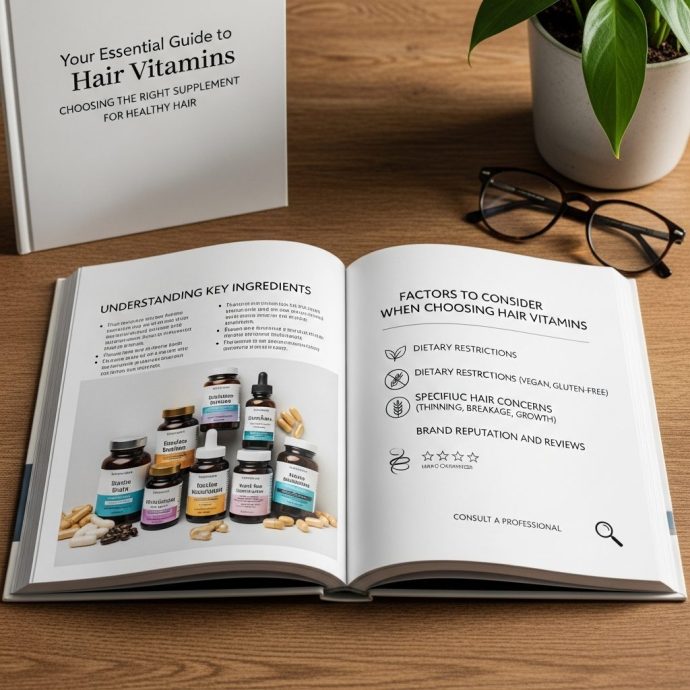Table of Contents
The Savvy Shopper’s Guide to Hair Vitamins: Nourish Your Locks from Within
Hair vitamins have flooded the market, promising longer, stronger, and shinier tresses in a single daily dose. With a dazzling array of bottles and compelling before-and-after photos, it’s easy to feel overwhelmed. How do you know which supplement is a powerful ally for your hair and which is just clever marketing? Choosing the right product isn’t about picking the prettiest packaging; it’s about understanding what your hair truly needs and how to identify high-quality ingredients. This guide will walk you through everything you need to know to make an informed and effective choice, helping you nourish your hair from the inside out.

The promise of vibrant, healthy hair is a universal desire, and the beauty industry has responded with a booming market for supplements designed to support hair health. These products aim to fill nutritional gaps that could be hindering your hair’s potential. However, not all supplements are created equal. To truly benefit from them, it’s essential to become a discerning consumer. This article will break down the science behind hair growth, highlight the key nutrients to look for, and provide a practical framework for selecting a supplement that aligns with your specific needs and goals.
Understanding the Building Blocks of Healthy Hair
Before diving into supplements, it’s crucial to understand what your hair is made of and how it grows. Hair is primarily composed of a protein called keratin. Your body produces keratin using amino acids, which are derived from the protein you eat. The hair growth process itself occurs in a cycle with three main phases:
- Anagen (Growth Phase): This is the active phase where hair follicles are pushing out strands. It can last for several years.
- Catagen (Transition Phase): A short phase where the hair follicle shrinks.
- Telogen (Resting Phase): The follicle is dormant for a few months before the hair sheds and a new anagen phase begins.
Vitamins and minerals play a vital role in supporting every stage of this cycle, from fortifying the keratin structure to ensuring follicles receive enough oxygen and nutrients to function optimally. A deficiency in key nutrients can shorten the anagen phase or lead to weaker hair, resulting in increased shedding and breakage.
Key Ingredients to Look For in Hair Vitamins
When you turn over a bottle, the ingredient list is your most powerful tool. A truly effective formula will contain a synergistic blend of vitamins, minerals, and other compounds known to support hair health. Here are the powerhouse ingredients you should look for.
- Biotin (Vitamin B7): Often the star ingredient, biotin is essential for producing keratin. While true biotin deficiency is rare, supplementing can help fortify hair and nails, especially for those with a known insufficiency.
- Iron: This mineral is critical for producing hemoglobin, which carries oxygen to all your body’s cells, including the hair follicles. Iron deficiency (anemia) is a very common cause of hair loss, particularly in women.
- Zinc: Zinc plays a crucial role in hair tissue growth and repair. It also helps keep the oil glands around the follicles working correctly. A lack of zinc can lead to a dry, flaky scalp and hair shedding.
- Vitamin C: A powerful antioxidant, Vitamin C protects hair follicles from damage caused by free radicals. More importantly, it is essential for the creation of collagen, a protein that strengthens hair strands.
- Vitamin D: Low levels of Vitamin D have been linked to alopecia (hair loss). This vitamin is thought to help in the creation of new follicles, which are the tiny pores from which new hair grows.
- Vitamin E: Similar to Vitamin C, Vitamin E is an antioxidant that can help prevent oxidative stress in the scalp. A healthy scalp is the foundation for healthy hair growth.
- Amino Acids: Look for L-cysteine and L-methionine, which are the building blocks of keratin. Including these directly in a supplement can provide your body with the raw materials needed to construct strong hair.
How to Choose the Best Hair Vitamins for Your Needs

With a solid understanding of key ingredients, you can now move on to selecting the right product. Use this checklist to evaluate your options and find the perfect match.
- Assess Your Personal Needs: Start by considering your primary concern. Is your hair thinning, breaking easily, or just not growing past a certain length? If you suspect thinning, it may be wise to get bloodwork done to check for deficiencies in iron or Vitamin D. If breakage is the issue, a formula rich in biotin and collagen-boosting Vitamin C might be more suitable.
- Examine Dosages and Forms: More isn’t always better. Mega-doses of certain vitamins (like Vitamin A) can be toxic and may even contribute to hair loss. Look for formulations that provide around 100% of the Daily Value (DV) for most ingredients. Additionally, research the bioavailability of the ingredients—some forms are more easily absorbed by the body than others.
- Read the Label for Quality: A high-quality supplement contains more than just active ingredients. Scrutinize the “other ingredients” list for unnecessary fillers, artificial colors, sugars, and common allergens. The cleaner the formula, the better.
- Look for Third-Party Certification: Because the supplement industry is not heavily regulated, look for brands that voluntarily submit their products for third-party testing. Seals from organizations like USP, NSF, or ConsumerLab indicate that the product contains what it claims on the label and is not contaminated with harmful substances.
Beyond the Bottle: A Holistic Approach
While an excellent supplement can make a significant difference, it is not a magic pill. For the best results, hair vitamins should be part of a broader, holistic approach to hair care and wellness. A balanced diet rich in protein, fruits, and vegetables should always be your primary source of nutrients. Managing stress, getting adequate sleep, and using gentle hair care practices—like minimizing heat styling and avoiding tight hairstyles—are equally important for preserving the health and strength of your hair. Remember, patience is key; it can take 3-6 months of consistent use to see noticeable results as your hair goes through its growth cycles.
Conclusion
Choosing the right hair vitamins is a journey of empowerment. By understanding the fundamentals of hair biology, recognizing key ingredients, and critically evaluating products, you can move beyond the marketing hype and invest in a supplement that truly supports your hair health goals. Combine your chosen supplement with a nutritious diet and a mindful lifestyle to provide your hair with the comprehensive care it needs to thrive, giving you the confidence that comes with strong, radiant, and healthy locks.






